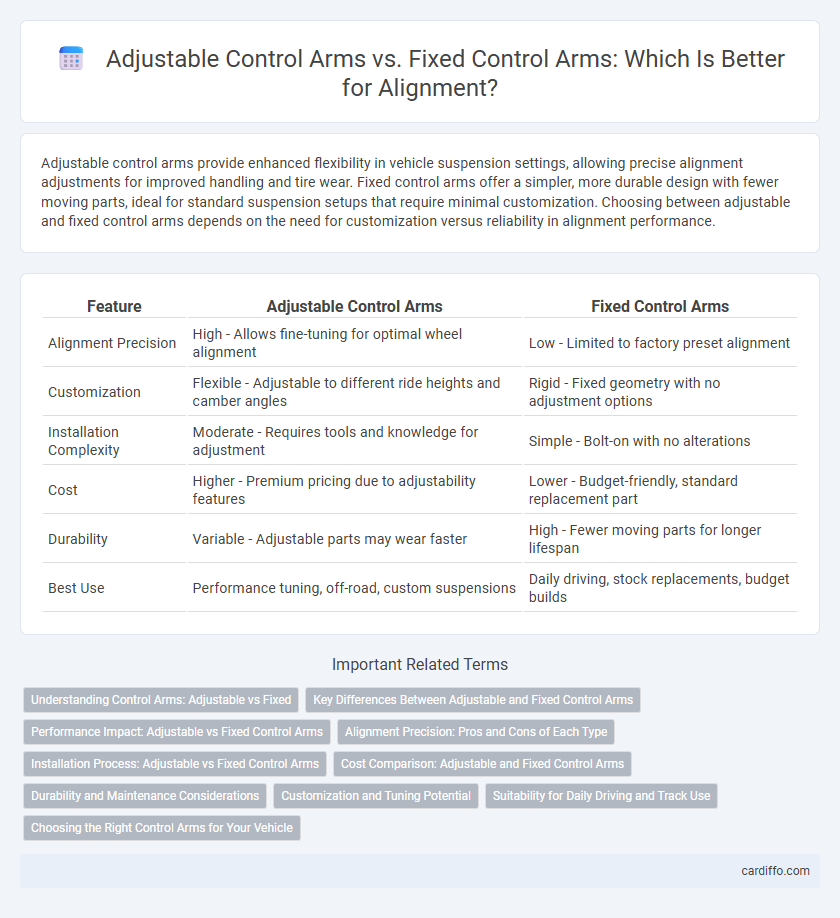Adjustable control arms provide enhanced flexibility in vehicle suspension settings, allowing precise alignment adjustments for improved handling and tire wear. Fixed control arms offer a simpler, more durable design with fewer moving parts, ideal for standard suspension setups that require minimal customization. Choosing between adjustable and fixed control arms depends on the need for customization versus reliability in alignment performance.
Table of Comparison
| Feature | Adjustable Control Arms | Fixed Control Arms |
|---|---|---|
| Alignment Precision | High - Allows fine-tuning for optimal wheel alignment | Low - Limited to factory preset alignment |
| Customization | Flexible - Adjustable to different ride heights and camber angles | Rigid - Fixed geometry with no adjustment options |
| Installation Complexity | Moderate - Requires tools and knowledge for adjustment | Simple - Bolt-on with no alterations |
| Cost | Higher - Premium pricing due to adjustability features | Lower - Budget-friendly, standard replacement part |
| Durability | Variable - Adjustable parts may wear faster | High - Fewer moving parts for longer lifespan |
| Best Use | Performance tuning, off-road, custom suspensions | Daily driving, stock replacements, budget builds |
Understanding Control Arms: Adjustable vs Fixed
Adjustable control arms provide enhanced flexibility in alignment settings by allowing fine-tuning of camber, caster, and toe angles, which is essential for optimizing tire wear and handling performance. Fixed control arms, while simpler and more durable due to their rigid construction, offer limited adjustment capabilities and often require additional components for alignment corrections. Selecting between adjustable and fixed control arms depends on the vehicle's usage, with adjustable arms favored in performance applications and fixed arms preferred for durability and cost-effectiveness.
Key Differences Between Adjustable and Fixed Control Arms
Adjustable control arms allow precise tuning of wheel alignment settings such as camber and caster angles, enhancing vehicle handling and tire wear optimization. Fixed control arms offer a simpler, more rigid design with limited adjustment capabilities, typically providing consistent factory alignment settings. The key difference lies in the flexibility adjustable control arms provide for suspension customization compared to the fixed, non-modifiable nature of fixed control arms.
Performance Impact: Adjustable vs Fixed Control Arms
Adjustable control arms offer enhanced performance by allowing precise suspension alignment adjustments, improving handling, tire wear, and overall vehicle stability compared to fixed control arms. Fixed control arms provide a consistent factory alignment setting but lack the flexibility to fine-tune camber and caster angles for optimized performance in different driving conditions. The ability to customize alignment in adjustable control arms directly translates to better traction and cornering capabilities, especially in high-performance and off-road applications.
Alignment Precision: Pros and Cons of Each Type
Adjustable control arms offer superior alignment precision by allowing fine-tuning of camber, caster, and toe settings, which improves handling and reduces tire wear. Fixed control arms provide consistent alignment geometry with less complexity and maintenance, but lack customization options, limiting their adaptability to different driving conditions or suspension modifications. Choosing between adjustable and fixed control arms depends on whether precise alignment customization or simplified, durable setup is prioritized.
Installation Process: Adjustable vs Fixed Control Arms
Adjustable control arms offer greater flexibility during the installation process by allowing precise adjustments to camber and caster angles without needing additional components. Fixed control arms have a simpler installation but require exact factory specifications, limiting alignment adjustments after mounting. Choosing adjustable control arms enhances alignment accuracy and simplifies customization for improved vehicle handling.
Cost Comparison: Adjustable and Fixed Control Arms
Adjustable control arms typically cost between $150 and $400 per pair, offering enhanced customization for precise alignment adjustments, which can reduce tire wear and improve handling. Fixed control arms usually range from $100 to $250 per pair and provide a durable, cost-effective solution but lack the flexibility for fine-tuning alignment settings. Choosing adjustable arms involves a higher initial investment but can save money over time by optimizing suspension geometry and preventing uneven tire wear.
Durability and Maintenance Considerations
Adjustable control arms offer enhanced durability by allowing precise alignment adjustments, reducing wear on suspension components and improving overall lifespan. Fixed control arms require less frequent maintenance due to their simpler design but may cause uneven tire wear and quicker suspension degradation if misaligned. Choosing between adjustable and fixed control arms depends on balancing the need for customization against long-term maintenance demands.
Customization and Tuning Potential
Adjustable control arms offer superior customization and tuning potential compared to fixed control arms by allowing precise alignment adjustments for camber, caster, and toe angles. This flexibility enhances vehicle handling, tire wear optimization, and suspension geometry modifications tailored to specific driving conditions or performance goals. Fixed control arms provide limited alignment settings, restricting fine-tuning capabilities and adaptability for performance enhancements or compensating for aftermarket suspension components.
Suitability for Daily Driving and Track Use
Adjustable control arms offer precise alignment customization, making them ideal for track use where fine-tuning camber and toe settings enhance handling and tire wear. Fixed control arms provide a more straightforward, durable setup that suits daily driving by maintaining factory alignment settings with minimal maintenance. For drivers who alternate between street and track, adjustable control arms deliver versatility, while fixed control arms prioritize reliability and ease of use in everyday conditions.
Choosing the Right Control Arms for Your Vehicle
Choosing the right control arms for your vehicle depends on your driving needs and alignment precision requirements. Adjustable control arms offer enhanced customization for suspension geometry, allowing for precise camber, caster, and toe adjustments that improve handling and tire wear. Fixed control arms provide a durable, cost-effective solution with consistent alignment settings but lack the flexibility needed for performance tuning or frequent alignment changes.
Adjustable Control Arms vs Fixed Control Arms Infographic

 cardiffo.com
cardiffo.com